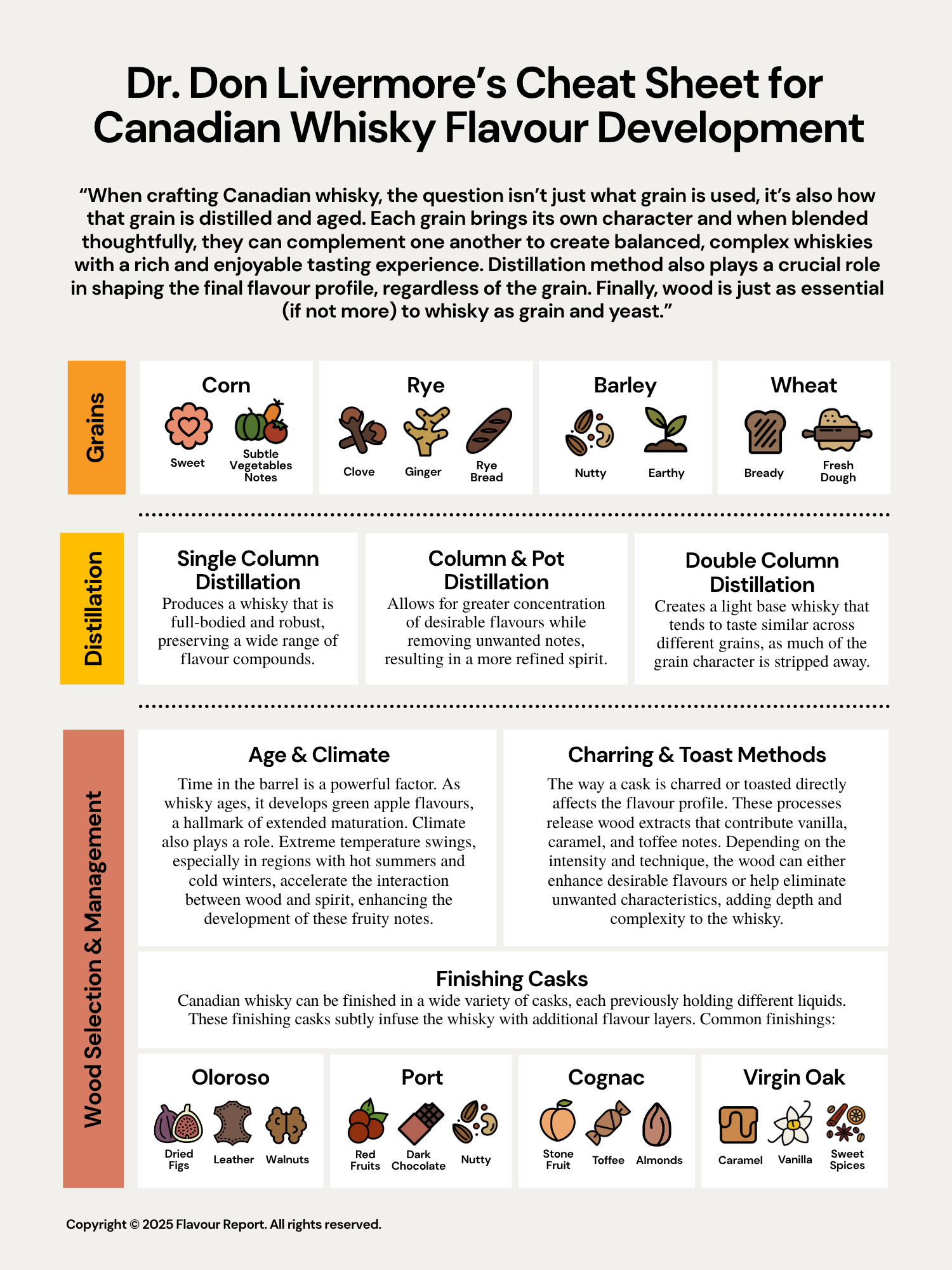Masters of Flavour: Andrea Fujarczuk & Dr. Don Livermore
Exploring mentorship, blending mastery, and how Canadian whisky’s identity continues to evolve.
Dr. Don Livermore & Professor Andrea Fujarczuk
What do you get when a master blender and a whisky professor compare notes on Canada’s liquid identity?
Through the OurWhisky Foundation’s Atonia Programme, Andrea Fujarczuk, Professor and Program Coordinator for Artisan Distilling at Niagara College, connected with Dr. Don Livermore, Master Blender at Hiram Walker & Sons, in a mentorship that bridges the gap between academic research and industry practice. Andrea, who is completing her Doctorate in Business Administration at Heriot-Watt University with research focused on the role of values and country of origin in the Canadian whisky market, brings a perspective rooted in education, data, and cultural insight. Dr. Livermore, a pioneer in applying grain science and wood chemistry to whisky blending, offers a lifetime of experience turning research into real-world flavour.
Their conversation moves beyond mentorship into a deeper exploration of what defines Canadian whisky today: how perception has changed, how innovation is guided by science and tradition, and why mentorship remains vital to shaping the category’s future.
AF: Looking back, what are the key moments in your career that defined your approach to blending and innovation?
DL: With a background in microbiology, I started my career by diving deep into the fermentation science behind whisky production. Yeast plays a critical role, it’s responsible for developing many of the key flavour notes in whisky, including fruity, floral, green grass, soapy, and even sulphurous tones. I had the opportunity to optimize yeast performance, knowing that yeast truly is the heartbeat of the distillery.
Beyond fermentation, I collaborated with local agricultural partners to introduce unique hybrids of rye, corn, wheat, and barley into our distillery. This allowed us to better understand how each grain contributes to the overall flavour profile of our blends, giving us more control and creativity in crafting distinctive whiskies.
A defining chapter in my career was my PhD research on wood interaction with spirits. We were among the first in Canada to explore the use of new oak barrels, and how they influence flavour development. This work directly impacted the creation of expressions like JP Wiser’s Legacy and Lot 40 Dark Oak, which showcase the depth and complexity that wood can bring to whisky.
For a Master Blender, it’s essential to understand every aspect of whisky production from grain to glass. With this foundation, we can connect with consumers, anticipate evolving tastes, and design whiskies that resonate today and inspire tomorrow.
AF: How has the perception of Canadian whisky’s “place” changed globally over the course of your career?
DL: The perception of Canadian whisky has evolved significantly over the past few decades. In the 1990s and early 2000s, it was largely seen as a value proposition, coinciding with a slowdown in the industry. However, the 2010s marked a shift toward premiumization, and today, we’re witnessing a surge in super-premium releases from Canadian producers.
Notable examples include ultra-aged expressions such as JP Wiser’s 24, 28, and 42-year-old whiskies, as well as innovative barrel finishes like Pike Creek 21-year Oloroso and Lot 40 Cask Strength finished in cherry wood. These releases reflect a growing curiosity and appreciation for the art of blending in Canadian whisky.
As a blender, I’m often approached by colleagues from other whisky categories who are eager to learn about our blending philosophies. The world is increasingly captivated by the art of blending, where myriad flavours converge to create something truly unique.
AF: What flavours do you think best represent Canadian whisky to the world?
DL: Traditionally, rye has been considered the cornerstone of Canadian whisky. To help explain its role, I often use the analogy of ordering a spicy dish at a restaurant. When you order, the server might ask, “On a scale from one to ten, how spicy would you like it?” Canadian whisky works the same way. Rye is our spice.
On the mild end of the spectrum, closer to a one, you’ll find smooth, approachable whiskies like JP Wiser’s Deluxe, which are light and easy-drinking. On the opposite end, at a ten, are bold, full-bodied whiskies like Lot No. 40, made from 100 per cent rye. These whiskies deliver a powerful, lingering warmth in the chest — a sensation we affectionately call the Canadian hug.
You can often gauge the amount of rye in a whisky by how long that warm feeling lasts. As a Master Blender, I use that rye intensity as a guide to select the right casks, whether it’s new oak, toasted wood, or barrels that previously held wine or other spirits. Each cask type interacts differently with the rye, helping to balance the final flavour profile.
AF: If you could define the future flavour profile of Canadian whisky, what would it be?
DL: I believe the future of Canadian whisky will be shaped by regional markets, driven by a growing curiosity and desire for personalization. Consumers are seeking whiskies that reflect their tastes, cultures, and experiences, while still offering great value at a fair price.
As a Master Blender, my role is to prepare our inventory so that future blenders have the tools they need to meet these evolving demands. That means building a diverse and flexible whisky portfolio — one that includes a wide range of grains, cask types, and flavour profiles. As I previously mentioned, it’s about ensuring that the toolbox of tomorrow is even more robust than the one I inherited.
Innovation isn’t just about creating something new, it’s about anticipating what’s next, and laying the groundwork for whiskies that will resonate five, 10, or even 40 years from now.


